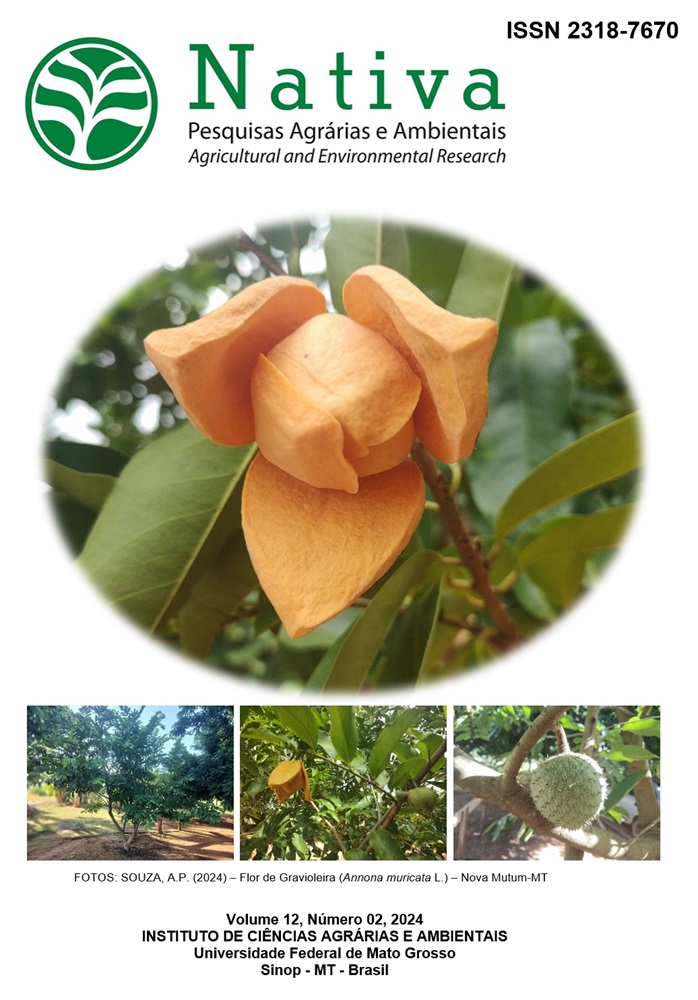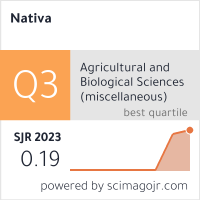TOLERÂNCIA DE CULTIVARES DE Megathyrsus maximus AO ESTRESSE HÍDRICO
DOI:
https://doi.org/10.31413/nat.v12i2.15729Palavras-chave:
alagamento, déficit hídrico, Panicim maximumResumo
O Brasil é um país com grande diversidade edafoclimática, de modo que a pecuária pode estar localizada em regiões sujeitas ao déficit hídrico e alagamento. Diante disso, é importante conhecer a resposta dos cultivares forrageiros a estas condições de estresse hídrico. Sendo assim, objetivou-se com esse trabalho identificar qual a tolerância ao estresse hídrico (déficit hídrico e alagamento) de cultivares de Megathyrsus maximus. O delineamento experimental utilizado foi o delineamento inteiramente casualizado, com nove tratamentos e quatro repetições, dispostos em esquema fatorial 3x3. Foram testados três cultivares de Megathyrsus maximus (Tamani, Zuri e Quênia), submetidos a três condições hídricas (déficit hídrico, sem estresse hídrico e alagamento). Todas as gramíneas reduziram a produção de massa de forragem quando submetidas ao estresse hídrico (déficit e alagamento). O capim Tamani foi a gramínea com maior redução na massa de forragem diante de alagamento. O perfilhamento e o filocrono do capim do Zuri não foram afetados pelo estresse hídrico e, após o estresse, restabeleceu o número de folhas emitidas, independentemente do tipo de estresse. Todos os capins recuperaram a massa de forragem após o déficit hídrico, contudo, houve comprometimento no desenvolvimento após o alagamento. Dessa forma, todos os capins têm baixa tolerância ao déficit hídrico, mas são capazes de recuperar após o estresse. Dos cultivares testados, o capim Tamani é o cultivar de Megathyrsus maximus com menor tolerância ao alagamento e o Zuri é o capim com maior tolerância ao estresse hídrico.
Palavras-chave: alagamento; déficit hídrico; Panicum maximum.
Tolerance of Megathyrsus maximus cultivars to water stress
ABSTRACT: Brazil has great edaphoclimatic diversity, so that livestock can be located in regions subject to water deficit and flooding. Therefore, it is important to know the response of forage cultivars to these water stress conditions. Thus, this work aimed to identify the tolerance to water stress (water deficit and flooding) of some Megathyrsus maximus cultivars. The experimental design was completely randomized, with nine treatments and four replications arranged in a 3x3 factorial scheme. Three Megathyrsus maximus cultivars (Tamani, Zuri and Kenya) were tested and submitted to three water conditions (water deficit, without water stress and flooding. All grasses reduced forage mass production when subjected to water stress (deficit and flooding). Tamani grass had the greatest reduction in forage mass in the face of flooding. The tillering and phyllochron of Zuri grass were not affected by water stress; after stress, the number of leaves emitted was restored, regardless of the type of stress. All grasses recovered forage mass after the water deficit. However, there was compromised development after the flooding. In this way, all grasses have a low tolerance to water deficit but can recover after stress. Of the tested cultivars, Tamani grass is the cultivar of Megathyrsus maximus with the lowest tolerance to flooding, and Zuri is the grass with the highest tolerance to water stress.
Keywords: flooding; water deficit; Panicum maximum.
Referências
ARAÚJO JÚNIOR, G.; GOMES, F. T.; SILVA, M. J.; JARDIM, A. M. F. R.; SIMÔES, V. J. L. P.; IZIDRO, L. P. S.; LEITE, M. L. M. V. TEIXEIRA, V. I.; SILVA, T. G. F. Estresse hídrico em plantas forrageiras: Uma revisão. Pubvet, v. 13, p. 1-10, 2019. https://doi.org/10.31533/pubvet.v13n01a241.1-10
BARBERO, R. P.; BARBOSA, M. A. A. F.; CASTRO, L. M.; RIBEIRO, E. L. A.; MIZUBUTI, I. Y.; BUMBIERIS JUNIOR, V. H.; SILVA, L. D. F. Características produtivas e morfológicas do capim Tanzânia em diferentes intensidades de pastejo. Semina: Ciências Agrárias, v. 35, n. 1, p. 427-436, 2014. http://doi.org/10.5433/1679-0359.2014v35n1p427
BONFIM-SILVA, E. M.; SILVA, T. J. A.; CABRAL, C. E. A.; KROTH, B. E.; REZENDE, D. Desenvolvimento inicial de gramíneas, submetidas ao estresse hídrico. Revista Caatinga, v. 24, n. 2, p. 180-186, 2011.
BOURSCHEIDT, M. L. B.; CARMO, K. B.; PEDREIRA, B. C.; BERBER, G. C. M.; FERREIRA, A. Biodiversidade de bactérias antagônicas a fungos associados à síndrome da morte do capim-marandu (Brachiaria brizantha). Nativa, v. 9, n. 5, p. 454-459, 2021. https://doi.org/10.31413/nativa.v9i5.12666
CABRAL, C. E. A.; CABRAL, L. S.; BONFIM-SILVA, E. M.; CARVALHO, K. dos S.; ABREU, J. G.; CABRAL, C. H. A. Reactive natural phosphate and nitrogen fertilizers in Marandu grass fertilization. Comunicata Scientiae, v. 9, n. 4, p. 729-73, 2018.
CABRAL, C. E. A.; MOTTA, A. M.; SANTOS, A. R. M.; GOMES, J. F.; PEDREIRA, B. C.; CABRAL, C. H. A. Effects of timing of nitrogen fertilizer application on responses by tropical grasses. Tropical Grasslands-Forrajes Tropicales, v. 9, n. 2, p.182-191, 2021.
DIAS-FILHO, M. B. Diagnóstico das pastagens no Brasil. Belém: Embrapa Amazônia Oriental, 2014. 10p.
DIAS-FILHO, M. B.; DE CARVALHO, C. J. Physiological and morphological responses of Brachiaria spp. to flooding. Pesquisa Agropecuária Brasileira, v. 35, n. 10, p. 1959-1966, 2000.
DIAS-FILHO, M. B. Respostas morfofisiológicas de Brachiaria spp. ao alagamento do solo e a síndrome da morte do capim-marandu. Campo Grande: Embrapa Gado de Corte, 2006. 29p.
DUARTE, C. F. D.; POCHERA, D. L.; PAIVA, L. M.; FERNANDES, H. J.; BISERRA, T. T.; CASSARO, L. H.; FLORES. L. S.; FERNANDES, R. L. Morfogênese de braquiárias sob estresse hídrico. Arquivo Brasileiro de Medicina Veterinária e Zootecnia, v. 71, n. 5, p. 1669-1676, 2019. https://doi.org/10.1590/1678-4162-10844
DUARTE, M. L. R.; ALBUQUERQUE, F. C.; SANHUEZA, R. M. V.; VERZIGNASSI, J. R.; KONDO, N. Etiologia da podridão do coleto de Brachiaria brizantha em pastagens da Amazônia. Fitopatologia Brasileira, Brasília, v. 32, n. 3, p. 261-265, 2007.
GOMES, L. D.; LIMA, K. L. L; SILVA, G. B. A.; BORGES, L. C. O.; RIGHI, R. S. M.; DUARTE, C. F. D.; CABRAL, C. H. A.; CABRAL, C E. A. Tolerância de híbridos de braquiária ao estresse hídrico. Scientific Electronic Archives, v. 16, n. 10, p. 1-7, 2023. https://doi.org/10.36560/161020231792
HABERMANN, E.; OLIVEIRA, E. A. D.; CONTIN, D. R.; DELVECCHIO, G.; VICIEDO, D. O.; MORAES, M. A.; PRADO, R. M.; COSTA, K. A. P.; BRAGA, M. R.; MARTINEZ, C. A. Warming and water deficit impact leaf photosynthesis and decrease forage quality and digestibility of a C4 tropical grass. Physiologia Plantarum, v. 165, n. 2., p. 383-402, 2019. https://doi.org/10.1111/ppl.12891
HSIAO, T. C. Plant response to water stress. Plant Physiology, v. 24, n. 1, p. 519-570, 1973. http://doi.org/10.1146/annurev.pp.24.060173.002511
LARRÉ, C. F.; MOARES, C. L; BORELLA, J.; AMARANTE, L.; DEUNER, S.; PETERS, J. A. Antioxidant activity and fermentative metabolism in the plant Erythrina crista-galli L. under flood conditions. Semina: Ciências Agrárias, v. 37, n. 2, p. 567-580, 2016. https://doi.org/10.5433/1679-0359.2016v37n2p567
MASS JUNIOR, R.; DOMICIANO, L. F.; RIBEIRO, L. F. C.; PEDREIRA, B. C. Growth responses of nine tropical grasses under flooding conditions. Tropical Grasslands, v. 4, n. 1, p. 1-7, 2016. https://doi.org/10.17138/tgft(4)1-7
NAJEEB, U.; BANGE, M. P.; TAN, D. K.; ATWELL, B. J. Consequences of waterlogging in cotton and opportunities for mitigation of yield losses. AoB Plants, v. 7, n. esp., p. 1-17, 2015. https://doi.org/10.1093/aobpla/plv080
OLIVEIRA, E. M.; MARTUSCELLO. J. A.; JANK, L.; CUNHA, D. N. F. V.; SANTOS, M. F. Evaluation of Megathyrsus maximus genotypes under water stress conditions. Acta Scientiarum. Animal Sciences, v. 44, e54975, 2022. https://doi.org/10.4025/actascianimsci.v44i1.54975
PIMENTEL, R. M.; BAYÃO, G. F. V.; LELIS, D. L.; CARDOSO, A. J. S.; SALDARRIAGA, F. V.; MELO, C. C. V.; SOUZA, F. B. M.; PIMENTEL, A. C. S.; FONSECA, D. M.; SANTOS, M. E. R. Ecofisiologia de plantas forrageiras. PubVet, v. 10, n. 9, p.666-679, 2016.
RIBEIRO JÚNIOR, N. G.; ARIANO, A. P. R.; SILVA, I. V. Death of pasture syndrome: tissue changes in Urochloa hybrida cv. Mulato II and Urochloa brizantha cv Marandu. Brazilian Journal of Biology, v. 77, p. 97-107, 2017a. https://doi.org/10.1590/1519-6984.10715
RIBEIRO JUNIOR, N. G.; SILVA, I. V.; ARAÚJO, C. F.; FAGUNDES, O. S.; GERVAZIO, W. Anatomia e morfometria de raízes e folhas de Urochloa brizantha cv. Marandu em diferentes estádios de acometimento da síndrome da morte das pastagens. Iheringia, v. 72, n. 1, p. 127-132, 2017b. https://doi.org/10.21826/2446-8231201772111
SANTOS, H. G.; JACOMINE, P. K. T.; ANJOS, L. H. C.; OLIVEIRA, V. A.; LUMBRERAS, J. F.; COELHO, M. R.; ALMEIDA, J. A.; ARAÚJO FILHO, J. C.; OLIVEIRA, J. B.; CUNHA, T. J. F. Sistema brasileiro de classificação de solos. Brasília, DF: Embrapa, 2018. 356 p.
TESK, C. R. M.; CAVALLI, J.; PINA, D. S.; PEREIRA, D. H.; PEDREIRA, C. G. S.; JANK, L.; SOLLENBERGER, L. E.; PEDREIRA, B. C. Herbage responses of Tamani and Quênia guineagrasses to grazing intensity. Agronomy Journal, v. 112, n. 3, p. 2081-2091, 2020. https://doi.org/10.1002/agj2.20189
VICIEDO, D. O.; PRADO, R. M.; MARTINEZ, C. A.; HABERMANN, E.; BRANCO, R. B. F.; PICOLLO, M. C.; HURTADO, A. C.; CALZADA, K. P.; TENESACA, L. F. T. Water stress and warming impact nutrient use efficiency of Mombasa grass (Megathyrsus maximus) in tropical conditions. Journal of Agronomy and Crop Science, v. 207, n. 1, p. 128-138, 2021. https://doi.org/10.1111/jac.12452
Downloads
Publicado
Edição
Seção
Como Citar
Licença
Copyright (c) 2024 Nativa

Este trabalho está licenciado sob uma licença Creative Commons Attribution-NonCommercial 4.0 International License.
Direitos Autorais para artigos publicados nesta revista são do autor, com direitos de primeira publicação para a revista. Em virtude de a aparecerem nesta revista de acesso público, os artigos são de uso gratuito, com atribuições próprias, em aplicações educacionais e não-comerciais.
A artigos publicados nessa revista, podem ser reproduzidos parcialmente ou utilizados como referência por outros autores, desde que seja cita a fonte, ou seja, a Revista Nativa.
Copyright for articles published in this journal are the authors, with first publication rights granted to the journal. The journal shows open access, and articles are free to use, with proper attribution, in educational and non-commercial.
The articles published in this journal may be reproduced in part or used as a reference by other authors, provided that the source is quoted.






